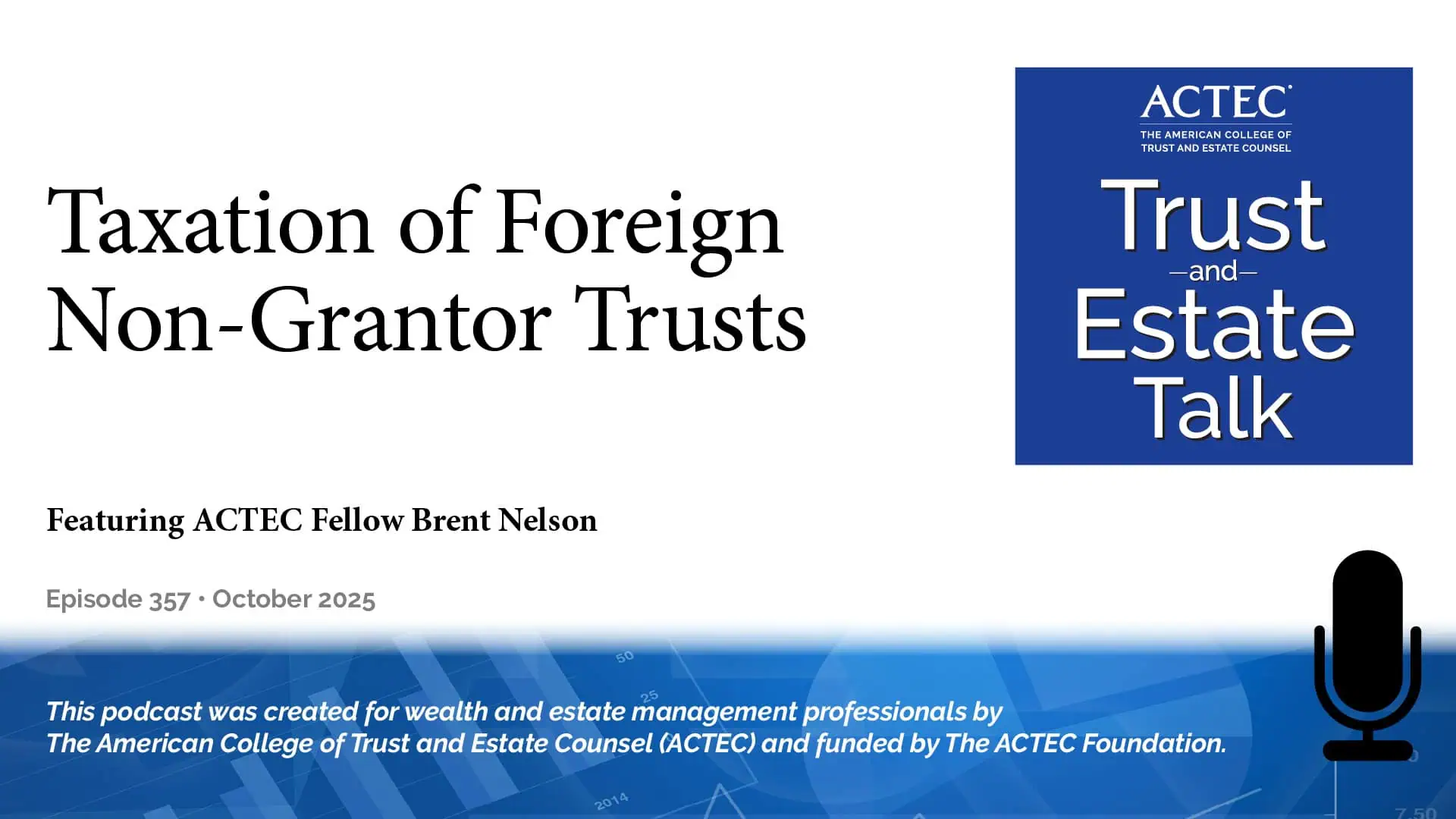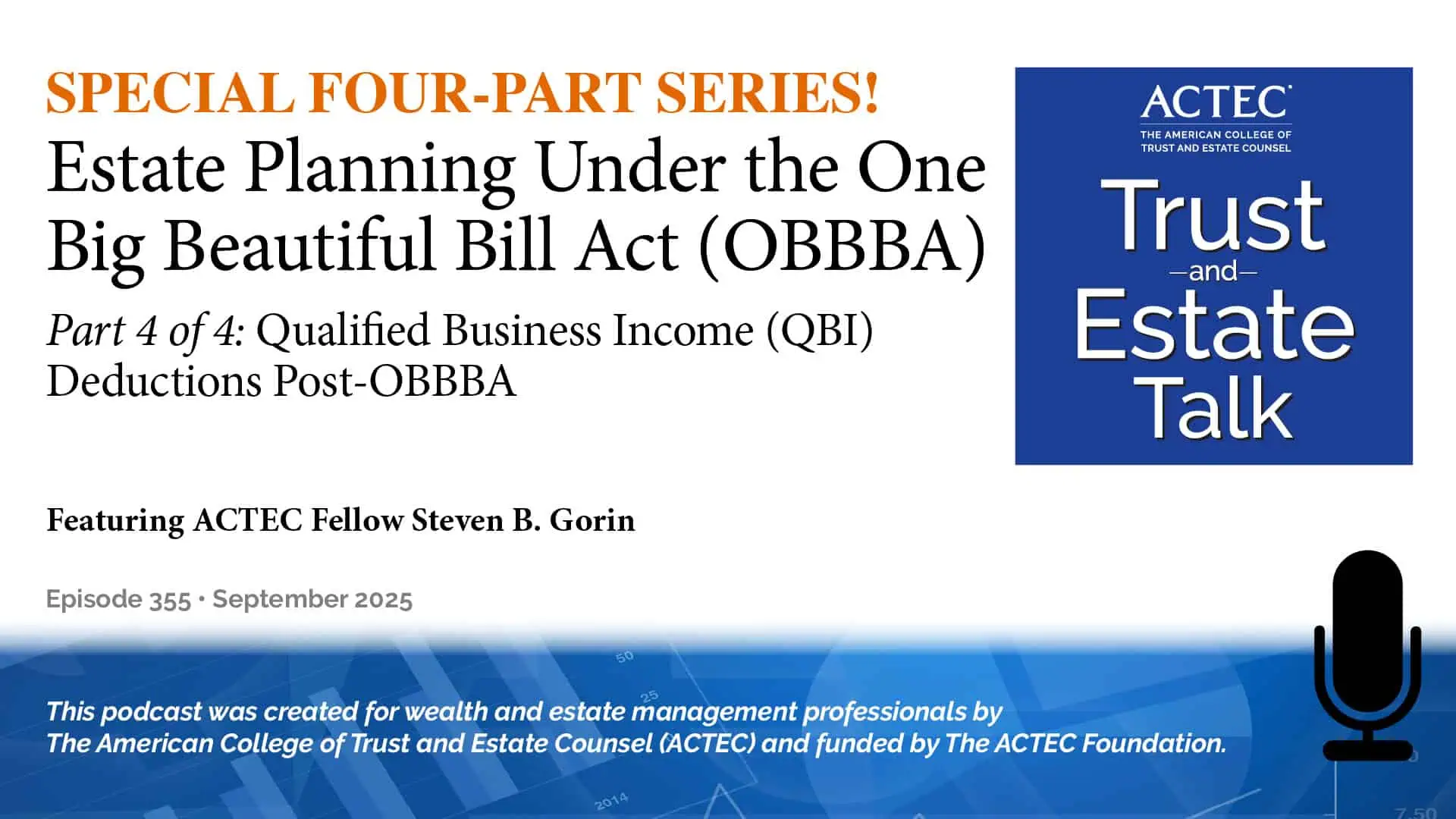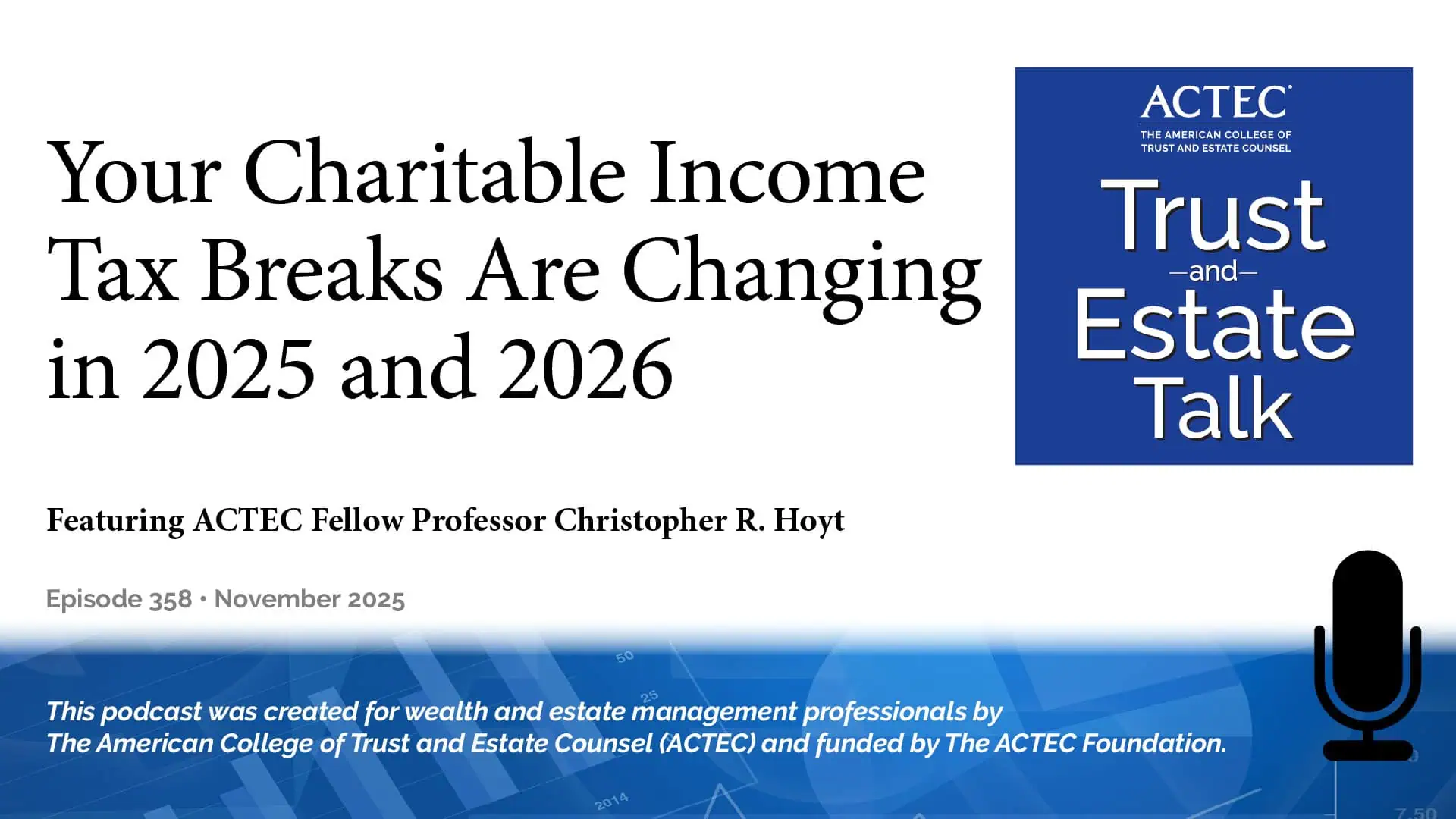Your Charitable Income Tax Breaks Are Changing in 2025 and 2026
“Your Charitable Income Tax Breaks Are Changing in 2025 and 2026,” that’s the subject of today’s ACTEC Trust and Estate Talk.
Transcript/Show Notes
This is Natalie Perry, ACTEC Fellow from Chicago.
The One Big Beautiful Bill Act was signed into law on July 4, 2025. It marked the most significant overhaul of federal tax legislation since 2017, impacting taxes, credits, and deductions across the board. We recorded a series of podcasts on the bill. Charitable income tax is one of the areas where there is an urgency for professionals and taxpayers to understand the changes and their impact when filing 2025 taxes.
ACTEC Fellow Professor Christopher Hoyt at University of Missouri School of Law in Kansas City is with us to highlight charitable deductions and what you need to know for end-of-year income tax planning. Welcome, Chris.
Understanding the One Big Beautiful Bill Act (OB3)
Professor Christoper Hoyt: Well, thank you, Natalie. We’re going to go through year-end tax planning because there’s been a lot of changes made by the One Big Beautiful Bill Act. In Washington, DC they call it OB3, I kind of like that for two reasons: first of all, it has kind of a Star Wars feel to it and second, as we look at some of these changes to the charitable tax laws, they do look like they came from a galaxy far, far away.
The first thing we’ll talk about is the charitable deduction is normally an itemized deduction, but only about 10% of taxpayers itemize. 90% use the standard deduction. Beginning next year in 2026, people who take the standard deduction and do not itemize will be able to get an income tax deduction for some of the charitable gifts. It’s a maximum of $1,000 on single returns and a maximum of $2,000 on married filing joint returns. The standard deductions for 2025 are $15,750 single, $31,000 married. And so with that kind of threshold, people will usually take the standard deduction.
New Above-the-Line Deduction for Non-Itemizers
This is an above-the-line deduction if you don’t itemize. Only cash gifts qualify. You cannot get the deduction for gifts of household items or clothing and things like that. There are a few charities that don’t qualify, you can’t get this deduction if you give to a Donor Advised Fund (DAF), a private grant-making foundation, or a Section 5093 supporting organization.
The donor will need the same kind of acknowledgement for gifts over $250 from the charities called a Contemporaneous Written Acknowledgement, and it has to say you received no goods or services and things like that.
When “January Is the New December”
So if this takes place in 2026, part of your year-end 2025 tax planning might be to defer your usual December gifts into January when you’ll be able to deduct them; January is the new December. And that would make sense for people who donate less than $1,000 a year or $2,000 a joint return. If though, you do donate more than $1,000 or $2,000 every year, then don’t bother with deferring the gifts into next year, you’ll reach the 2026 limit anyway.
Another change is that more taxpayers will be able to itemize. Normally about only 10% of taxpayers itemize, but we think 14% will itemize in 2025 and 2026. And the reason is that the amount that you can deduct for your state and local taxes, which have been limited to $10,000 in 2024, is increasing to $40,000 for the years 2025 through 2029.
So higher income taxpayers are more likely to pay more state and local income tax and property tax than lower income taxpayers. They might be able to deduct more and might be able to itemize, though the highest income taxpayers won’t benefit from this. If your income is over $500,000, we phase out that $40,000 deduction and bring it back down to $10,000. Once your income is over $600,000, you’re stuck with the old $10,000 limit.
Taxpayers near the $500,000 threshold, try to find ways to reduce their income below $500,000 to take advantage of the full $40,000 deduction. And this $40,000 deduction is retroactive to the beginning of the year 2025. So you might be more likely to itemize because states with high income taxes like the Northeast or California are more likely to be able to have their itemized deductions exceed the $15,000 single or $31,000 married amount.
Donations from Your IRA
Now, before we get into these rules, I want to emphasize that your charitable tax planning strategies differ a lot depending on whether the donor is over the age of 70 ½ or under age 70 ½ . If the donor is over the age of 70 ½, they qualify for a special tax break that they can use their IRAs, their individual retirement accounts, to make the charitable gifts and the distributions that they make to the charities are excluded from their taxable income. They’re called Qualified Charitable Distributions or QCDs.
So, if your donors over the age of 70 ½, you don’t have to worry about these rules I’m about to tell you. They can use their IRA to give away up to $108,000 in 2025 and exclude it from their income. And we did a podcast early in 2025 and we’ll have links to that in this page. So for donors over the age of 70 ½, don’t worry about what I’m going to talk about, but for donors under the age of 70 ½, they generally don’t want to use their IRA for charitable giving. They especially want to avoid using their IRA for charitable giving if they’re under the age of 59 ½, because in that case, not only do they have taxable income, but there’s a 10% penalty for distributions. So they might want to itemize and normally the best asset to use for charitable giving under the age of seven and a half is appreciated stock.
Charitable Deduction Floor Begins in 2026
If you do itemize your deductions, there are two changes that affect taxpayers in the year 2025 and 2026. And that is beginning in the year 2026, individuals can only deduct charitable gifts that exceed ½ of 1% of their adjusted gross income. So, we’re going to look at a married couple that has $200,000 of income, they might give $4,000 to charity. In the year 2025, they can deduct all $4,000. In the year 2026, the first $1,000 will not produce a tax benefit and they can only deduct $3,000.
The second tax change for people who itemize their deductions is if you’re wealthy and you’re in the 37% income tax bracket, which for individuals kicks in about a single people $615,000; married about $730,000. If you have income over that amount, you are in the highest income tax bracket of 37%. And the new law provides that you have to reduce your itemized deductions, so you only get a 35% tax savings. For example, someone who’s got $900,000 of income gets an extra interest check of $100. They give that to charity. Their income goes up by $100 hit with a 37% tax rate, but their $100 gift to charity only produces a 35% tax savings.
Expanded SALT Deduction and Income Limits
Let’s look at what you can do for the year 2025. And I’m going to use a married couple that every year paid $35,000 to state and local taxes (SALT) but every year they donate $10,000 to charity and their adjusted gross income is $200,000.
Last year, 2024, the state and local tax limit that they could deduct was $10,000. They could only deduct $10,000 of the $35,000 of taxes. So, their itemized deductions were only $20,000. $10,000 were state and local tax, $10,000 charitable gifts, they took the standard deduction. But the year 2025, they can deduct up to $40,000 and they paid $35,000. So now in 2025, they can itemize, they have $45,000 of itemized deductions and that exceeds the standard deduction. So they can deduct all $10,000 of charitable gifts. But next year in 2026, they do the same thing, they give $10,000 of charity, they can only deduct $9,000 because in 2026, they have to reduce the charitable deductions by one half of 1% of their $200,000 of AGI. So as they give $10,000 of charity, the first $1,000 produces no tax benefit.
So year in tax planning for 2025 is to make more gifts. You might put $40,000 into a Donor Advised Fund, you’ll deduct all of it in 2025. And then next year, the Donor Advised Fund might distribute the $10,000 of charity when you would have only gotten a $9,000 income tax savings.
High-Income Donors Face Reduced Tax Savings
The last thing, of course, is what I talked about. If you’re in the 37% tax bracket, your shareable deductions only produce 35% tax savings. And some commentators believe this also applies to trusts and estates. And a trust or an estate is in a 37% tax bracket with just $16,000 of income. And will their charitable gifts only produce 35% tax savings?
The bottom line is for your donors who are over the age of 70 ½, they can avoid all this complexity by giving from their retirement accounts. Most donors over the age of 70 1/2 should make all of their shareable gifts from their IRAs. Their IRA can be their shareable foundation. And then in that case, they’re not hit with a 1.5% or 1% limit for itemized deductions. And if then the 37% tax bracket, the gift from their IRA, which is excluded from income, saves them the full 37%.
And in that case, I refer you to the ACTEC webinar that we did in April of 2025 on Qualified Charitable Distributions. Thank you.
Natalie Perry: Thank you, Chris, for that informative presentation.
You may also be interested in:
- Qualified Charitable Distributions (QCD) from IRAs (Apr 2025)
- An Introduction to Individual Donor Advised Funds | DAF (Oct 2019)
Latest ACTEC Trust and Estate Talk Podcasts

Taxation of Foreign Non-Grantor Trusts
Learn how U.S. tax rules affect foreign non-grantor trusts and discover key strategies for cross-border estate planning and compliance.

How Artificial Intelligence (AI) Is Redefining Publicity Rights
Explore how AI, deepfakes, and digital replicas are reshaping publicity rights, estate planning, and legacy protection.

Qualified Business Income (QBI) Deductions Post-OBBBA
Learn how the One Big Beautiful Bill Act changes the Qualified Business Income (QBI) Deduction, expanding phase-in ranges and tax planning opportunities.



